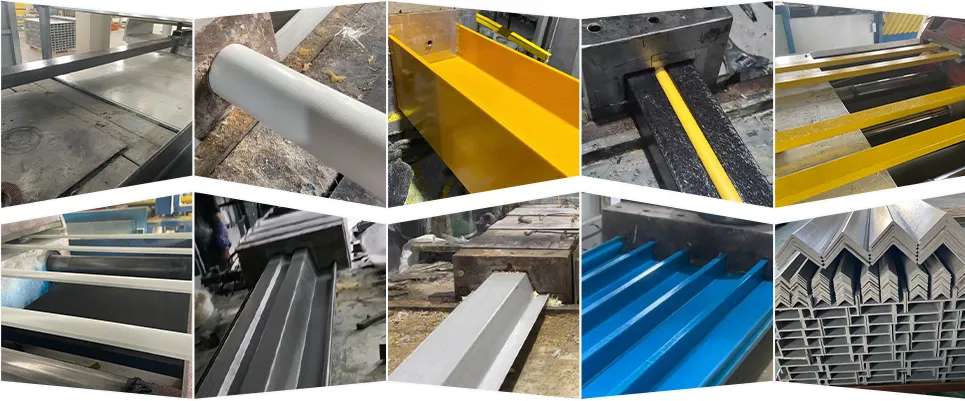loading...
- No. 9, Xingyuan South Street, Dongwaihuan Road, Zaoqiang County, Hengshui, Hebei, China
- admin@zjcomposites.com
- +86 15097380338
- Welcome to visit our website!
frp channel price
Understanding FRP Channel Prices Factors and Trends
Fiberglass Reinforced Plastic (FRP) channels are widely used in various industries due to their excellent mechanical properties, resistance to corrosive environments, and lightweight characteristics. As the demand for FRP products continues to rise, understanding the pricing dynamics of FRP channels becomes essential for businesses, contractors, and manufacturers alike.
Factors Influencing FRP Channel Prices
1. Raw Material Costs The primary component of FRP channels is fiberglass, which is derived from glass fibers. Fluctuations in the price of raw materials, including resin and fiberglass, directly impact the overall cost of FRP channels. Market conditions, production rates, and scarcity of specific materials can cause these prices to fluctuate.
2. Manufacturing Process The method employed in producing FRP channels also plays a critical role in cost determination. Advanced manufacturing techniques, such as pultrusion, involve specialized equipment and technology, resulting in higher initial costs but potentially lower production costs for large volumes. Conversely, traditional methods may incur higher labor costs, impacting the final price.
3. Market Demand and Supply The balance between demand and supply is a crucial determinant of pricing. During construction booms or increased utility projects, the demand for FRP channels can surge, driving up prices. However, if supply exceeds demand, prices may stabilize or decrease. Economic conditions, such as recessions or trade agreements, can also influence demand patterns in various sectors.
4. Customization and Specifications FRP channels can be tailored to meet specific requirements, including strength, size, and environmental resistance. Customization often leads to increased costs due to the additional labor, materials, and design considerations required. Standard specifications may offer cost benefits, but specific applications sometimes necessitate bespoke solutions that can raise prices.
frp channel price

5. Geographical Location The location of manufacturing plants and the cost of transportation can affect pricing. For example, regions with established infrastructure for FRP production may offer lower prices due to reduced shipping costs. In contrast, transporting FRP channels over long distances can inflate prices due to freight charges.
Current Trends in FRP Channel Pricing
Recent market trends indicate an increase in the adoption of FRP materials in construction, automotive, and marine industries, contributing to sustained price growth. As industries seek lightweight and corrosion-resistant materials to enhance efficiency and durability, the demand for FRP channels is expected to rise.
Moreover, sustainability concerns are shaping the market. Manufacturers are increasingly focusing on eco-friendly production methods, which may initially lead to higher costs but could yield long-term savings and environmental benefits. As technology advances, cost-effective recycling methods for FRP materials are emerging, potentially reducing raw material costs and influencing future pricing structures.
Conclusion
Understanding the pricing of FRP channels requires a multi-faceted approach. By considering the key factors influencing costs, such as raw material prices, manufacturing processes, and market dynamics, stakeholders can make informed decisions. As the demand for innovative materials continues to grow, staying updated on trends in pricing will be vital for those involved in the production or procurement of FRP channels. Ultimately, balancing cost with quality and sustainability will be essential for success in a competitive market.
-
The Rise of FRP Profiles: Strong, Lightweight, and Built to LastNewsJul.14,2025
-
SMC Panel Tanks: A Modern Water Storage Solution for All EnvironmentsNewsJul.14,2025
-
GRP Grating: A Modern Solution for Safe and Durable Access SystemsNewsJul.14,2025
-
Galvanized Steel Water Tanks: Durable, Reliable, and Ready for UseNewsJul.14,2025
-
FRP Mini Mesh Grating: The Safer, Smarter Flooring SolutionNewsJul.14,2025
-
Exploring FRP Vessels: Durable Solutions for Modern Fluid HandlingNewsJul.14,2025
-
GRP Structures: The Future of Lightweight, High-Performance EngineeringNewsJun.20,2025
